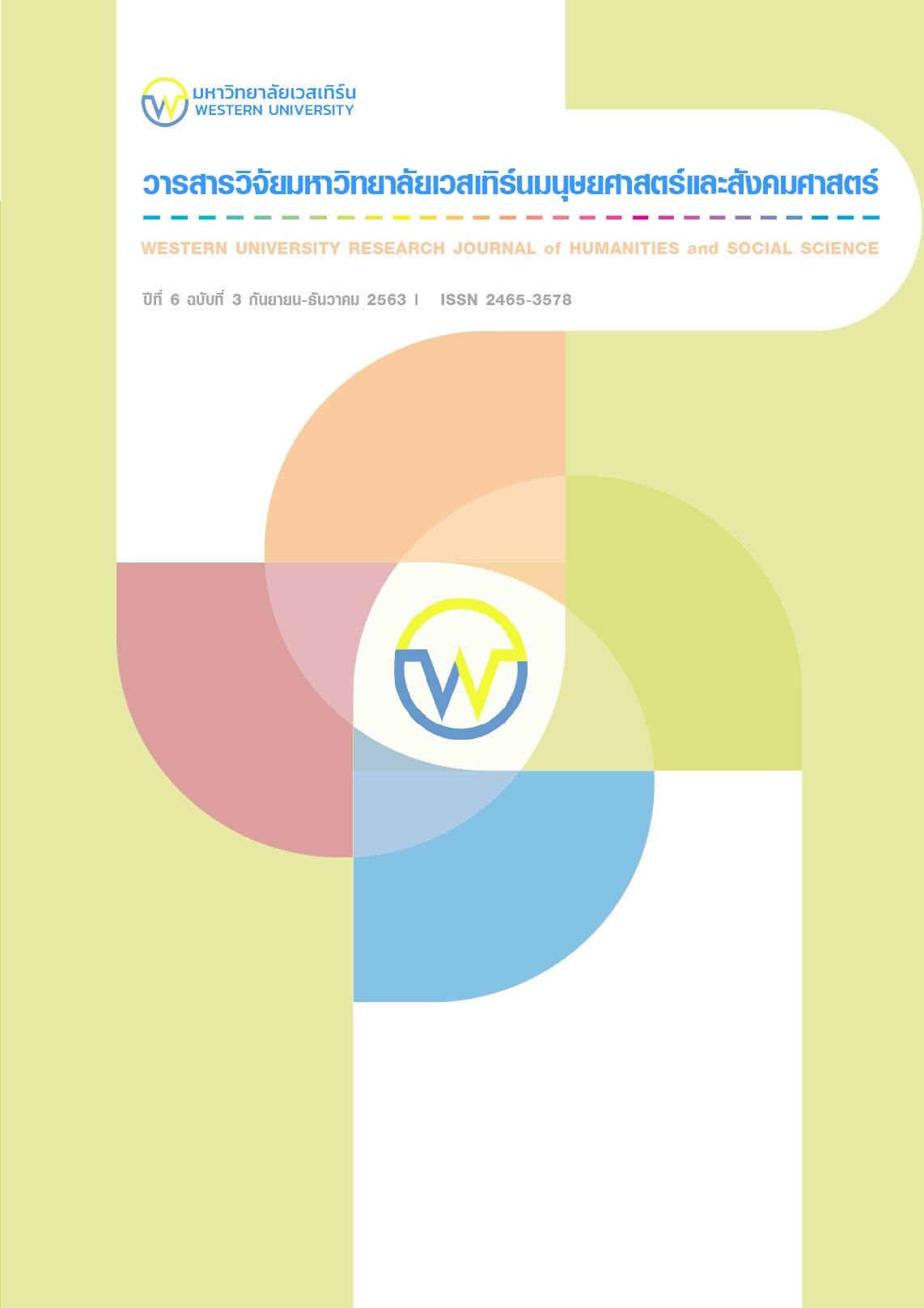ความสัมพันธ์เชิงโครงสร้างที่ส่งผลต่อผลการดำเนินงานของธุรกิจในอุตสาหกรรม การส่งออกซอฟต์แวร์ของผู้ประกอบการไทย
Main Article Content
บทคัดย่อ
การวิจัยนี้มีวัตถุประสงค์เพื่อศึกษาอิทธิพลของปัจจัยและการสร้างตัวแบบจำลองโครงสร้างความสัมพันธ์เชิงสาเหตุของผลการดำเนินงานของธุรกิจในอุตสาหกรรมการส่งออกซอฟต์แวร์ของผู้ประกอบการไทย จำนวนกลุ่มตัวอย่างคำนวณตามแนวคิดของ Hair et al. (2010) 360 ตัวอย่าง โดยใช้แบบสอบถามเป็นเครื่องมือในการเก็บรวบรวมข้อมูล สถิติเชิงพรรณา ที่ใช้ในการวิเคราะห์ ได้แก่ ค่าร้อยละ ค่าเฉลี่ย ส่วนเบี่ยงเบนมาตรฐาน ค่าสัมประสิทธิ์ความแปรปรวน ค่าความเบ้ และค่าความโด่ง สถิติเชิงอนุมานที่ใช้ในการวิเคราะห์ ได้แก่ ค่าสัมประสิทธิ์สหสัมพันธ์แบบเพียร์สัน ตัวแบบจำลองสมการโครงสร้าง (Structural Equation Modeling : SEM) โดยใช้โปรแกรม Analysis Moment of Structure (AMOS) ผลการศึกษาพบว่า ผู้ตอบแบบสอบถามส่วนใหญ่เป็นเพศชาย มีอายุระหว่าง 40-49 ปี มีระดับการศึกษาปริญญาโท มีตำแหน่งเป็นผู้บริหารระดับสูงและผู้จัดการ ระยะเวลาในการดำรงตำแหน่งบริหาร 5-10 ปี ผู้บริหารส่วนใหญ่แสดงความคิดเห็นต่อ ทุกองค์ประกอบในระดับมาก การทดสอบสมมติฐานพบว่า ทุกองค์ประกอบมีความสัมพันธ์กันอย่างมีนัยสำคัญที่ระดับ 0.01 ผลการวิเคราะห์ตัวแบบสมการโครงสร้างพบว่า การมุ่งเน้นตลาดมีอิทธิพลต่อการจัดการนวัตกรรม (TE=0.87) การมุ่งเน้นตลาดมีอิทธิพลต่อประสิทธิภาพในการแข่งขัน (TE=0.86) การมุ่งเน้นตลาดมีอิทธิพลต่อผลการดำเนินงาน (TE=0.62) การจัดการนวัตกรรมมีอิทธิพลลต่อประสิทธิภาพในการแข่งขัน (TE=0.66) การจัดการนวัตกรรมมีอิทธิพลต่อผลการดำเนินงาน (TE=0.01) ประสิทธิภาพในการแข่งขันมีอิทธิพลต่อผลการดำเนินงาน (TE=0.70) และความผันผวนของสภาพแวดล้อมทางธุรกิจ มีอิทธิพลต่อความสัมพันธ์ของการมุ่งเน้นตลาดกับผลการดำเนินงานของธุรกิจ (TE=0.10) สอดคล้องกับข้อสมมติฐาน ที่ระดับนัยสำคัญทางสถิติที่ระดับ 0.01 ส่วนการวิจัยเชิงคุณภาพ ดำเนินการเก็บรวบรวมข้อมูลจากเจ้าของกิจการหรือ ผู้บริการระดับสูง โดยการสัมภาษณ์เชิงลึกแบบกึ่งโครงสร้าง โดยการตรวจสอบความถูกต้องของข้อมูลแบบสามเส้า ผลการวิจัยพบว่า ข้อสรุปที่ได้จากการสัมภาษณ์เชิงลึกมีความสอดคล้องกับผลการวิจัยเชิงปริมาณในด้านการมุ่งเน้นตลาด การจัดการนวัตกรรม ประสิทธิภาพในการแข่งขัน ความผันผวนของสภาพแวดล้อมทางธุรกิจ และผลการดำเนินงานของธุรกิจ
Article Details
เอกสารอ้างอิง
สำนักงานปลัดกระทรวงเทคโนโลยีสารสนเทศและการสื่อสาร. (2554). กรอบนโยบายเทคโนโลยีสารสนเทศและการสื่อสารระยะ พ.ศ. 2554-2563 ของประเทศไทย ICT2020. สืบค้นเมื่อ 10 เมษายน 2561, จาก http://www.wise.co.th.
สำนักงานส่งเสริมเศรษฐกิจดิจิทัล. (2562). รายชื่อบริษัทในอุตสาหกรรมซอฟต์แวร์. สืบค้นเมื่อ 10 พฤษภาคม 2561, จาก http://www.depa.or.th.
สำนักงานส่งเสริมอุตสาหกรรมซอฟต์แวร์แห่งชาติ (องค์การมหาชน). (2560). รายงานประจำปี 2560. สืบค้นเมื่อ 10 เมษายน 2561, จาก http://www.sipa.or.th.
Abdolvand, M. A., ASL, A. M., Sadeghian, M., and Farzin, M. (2016). Investigation the effect of market orientation, social media marketing and international experience on global marketing strategy and company performance. International Journal of Life science & Pharma Research, 2, 93-101.
Abidemi, B. T., Halim, F. B., and Alshauibi, A. (2018). Environment turbulence, service marketing mix, market orientation and microfinance performance: A conceptual model. Journal of Business and Social Review in Emerging Economies, 4(1), 27-36.
Antonio, L., and Rodriguez, Leal. (2016). Linking market orientation, innovation and performance: an empirical study on small industrial enterprises in Spain. Strategy Journal of Small Business, 26(1), 37-49.
Creswell, J. W. (2013). Research design: qualitative, quantitative, and mixed methods approaches (2nd ed.). Thousand Oaks, CA: Sage publications.
Dorson, Thomas A. (2018). Customer involvement capability and service firm performance: The mediating role of innovation. Journal of Business Research, 86, 269-280.
Ferreira, Jorge, Coelho Arnaldo, and Moutinho Luiz. (2018). Dynamic capabilities, creativity and innovation capability and their impact on competitive advantage and firm performance: The moderating role of entrepeneurial orientation. Journal of Technovation, (In press).
Hair F. Joseph, Black C. William, Babin J. Barry, and Anderson E. Rolph. (2010). Multivariate data analysis (7th ed.). New Jersey: Pearson Education, Inc.
Hernandez-Perlines, Felipe, and Mancebo-Lozano Esteban. (2017). Condition destination of competitive strategy and environment in international entrepreneurial orientation of family business. European Journal of Family Business, 6, 86-98.
Jabeen, Rubina and Aliyu, Mukhtar Shehu and Mahmood, Rosli. (2016). The moderating effect of external environment on the relationship between market orientation and business performance: a quantitative approach. International Postgraduate Business Journal, 8 (1),16-25.
Jawad, Sakhawat, U. R. S., Naushad, S., Yousaf, S., and Yousaf, Z. (2020). Exploring performance of software houses: market orientation and mediating role of firm innovativeness. World Journal of Entrepreneurship, Management and Sustainable Development, 16(1), 1-11.
Jialu, Sun, et al. (2016). Entrepreneurial environment, market-oriented strategy, and entrepreneurial performance: A study of Chinese automobile firms. Internet Research, 26(2), 546-562.
Rajala, R., Rossi, M. and Tuunainen, K. V. (2003). A framework for analyzing software business model. Retrieve April 8, 2017, from http://citeseerx.ist. psu.edu /viewdoc/download?doi=10.1.1.100.6308&rep1&type=pdf.
Riasi, Arash. (2015). Competitiveness advantage of shadow banking industry: An analysis using Porter diamond model. Business Management and Strategy, 6(2), 15-27.
Rodriguez-Victoria, Orientha E., Puig Francisco, and Gonzalez-Loureiro Miguel. (2017). Clustering, innovation and hotel competitiveness: evidence from the Columbia destination. International Journal of Contemporary Hospitality Management, 29(11), 2785-2806.
Zhang, J., and Zhu, M. (2016). Market orientation, product innovation and export performance: evidence from Chinese manufacturers. Journal of Strategic Marketing, 24(5), 377-379.


